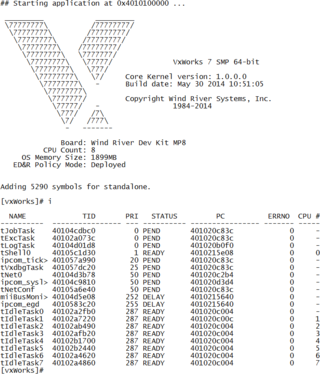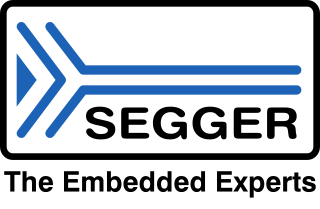
The GNU Debugger (GDB) is a portable debugger that runs on many Unix-like systems and works for many programming languages, including Ada, Assembly, C, C++, D, Fortran, Haskell, Go, Objective-C, OpenCL C, Modula-2, Pascal, Rust, and partially others.

An embedded system is a computer system—a combination of a computer processor, computer memory, and input/output peripheral devices—that has a dedicated function within a larger mechanical or electronic system. It is embedded as part of a complete device often including electrical or electronic hardware and mechanical parts. Because an embedded system typically controls physical operations of the machine that it is embedded within, it often has real-time computing constraints. Embedded systems control many devices in common use. In 2009, it was estimated that ninety-eight percent of all microprocessors manufactured were used in embedded systems.
pSOS is a real-time operating system (RTOS), created in about 1982 by Alfred Chao, and developed and marketed for the first part of its life by his company Software Components Group (SCG). In the 1980s, pSOS rapidly became the RTOS of choice for all embedded systems based on the Motorola 68000 series family architecture, because it was written in 68000 assembly language and was highly optimised from the start. It was also modularised, with early support for OS-aware debugging, plug-in device drivers, Internet protocol suite (TCP/IP) stacks, language libraries, and disk subsystems. Later came source code level debugging, multiprocessing support, and further computer networking extensions.

VxWorks is a real-time operating system developed as proprietary software by Wind River Systems, a subsidiary of Aptiv. First released in 1987, VxWorks is designed for use in embedded systems requiring real-time, deterministic performance and, in many cases, safety and security certification for industries such as aerospace, defense, medical devices, industrial equipment, robotics, energy, transportation, network infrastructure, automotive, and consumer electronics.

MontaVista Software is a company that develops embedded Linux system software, development tools, and related software. Its products are made for other corporations developing embedded systems and end products using Linux, such as automotive electronics, telecommunications and communications equipment, mobile phones, and other electronic devices and infrastructure. MontaVista also supplies Linux-based solutions and software to products that are software-only, such as enterprise networking, virtual network functions in Network Functions Virtualization, and appliance software that is hosted on a cloud hosting environment.
Nucleus RTOS is a real-time operating system (RTOS) produced by the Embedded Software Division of Mentor Graphics, a Siemens Business, supporting 32- and 64-bit embedded system platforms. The operating system (OS) is designed for real-time embedded systems for medical, industrial, consumer, aerospace, and Internet of things (IoT) uses. Nucleus was released first in 1993. The latest version is 3.x, and includes features such as power management, process model, 64-bit support, safety certification, and support for heterogeneous computing multi-core system on a chip (SOCs) processors.

The Blackfin is a family of 16-/32-bit microprocessors developed, manufactured and marketed by Analog Devices. The processors have built-in, fixed-point digital signal processor (DSP) functionality performed by 16-bit multiply–accumulates (MACs), accompanied on-chip by a microcontroller. It was designed for a unified low-power processor architecture that can run operating systems while simultaneously handling complex numeric tasks such as real-time H.264 video encoding.
Nios II is a 32-bit embedded processor architecture designed specifically for the Altera family of field-programmable gate array (FPGA) integrated circuits. Nios II incorporates many enhancements over the original Nios architecture, making it more suitable for a wider range of embedded computing applications, from digital signal processing (DSP) to system-control.
The MicroBlaze is a soft microprocessor core designed for Xilinx field-programmable gate arrays (FPGA). As a soft-core processor, MicroBlaze is implemented entirely in the general-purpose memory and logic fabric of Xilinx FPGAs.

FreeRTOS is a real-time operating system kernel for embedded devices that has been ported to 35 microcontroller platforms. It is distributed under the MIT License.
V850 is a 32-bit RISC CPU architecture produced by Renesas Electronics for embedded microcontrollers. It was designed by NEC as a replacement for their earlier NEC V60 family, and was introduced shortly before NEC sold their designs to Renesas in the early 1990s. It has continued to be developed by Renesas as of 2018.
LatticeMico32 is a 32-bit microprocessor reduced instruction set computer (RISC) soft core from Lattice Semiconductor optimized for field-programmable gate arrays (FPGAs). It uses a Harvard architecture, which means the instruction and data buses are separate. Bus arbitration logic can be used to combine the two buses, if desired.

Segger Microcontroller, founded in 1992, is a private company involved in the embedded systems industry. It provides products used to develop and manufacture four categories of embedded systems: real-time operating systems (RTOS) and software libraries (middleware), debugging and trace probes, programming tools, and in-system programmers. The company is headquartered in Monheim am Rhein, Germany, with remote offices in Gardner, Massachusetts; Milpitas, California; and Shanghai, China.
LynxSecure is a least privilege real-time separation kernel hypervisor from Lynx Software Technologies designed for safety and security critical applications found in military, avionic, industrial, and automotive markets.
DDC-I, Inc. is a privately held company providing software development of real-time operating systems, software development tools, and software services for safety-critical embedded applications, headquartered in Phoenix, Arizona. It was first created in 1985 as the Danish firm DDC International A/S, a commercial outgrowth of Dansk Datamatik Center, a Danish software research and development organization of the 1980s. The American subsidiary was created in 1986. For many years, the firm specialized in language compilers for the programming language Ada.
OVPsim is a multiprocessor platform emulator used to run unchanged production binaries of the target hardware. It has public APIs allowing users to create their own processor, peripheral and platform models. Various models are available as open source. OVPsim is a key component of the Open Virtual Platforms initiative (OVP), an organization created to promote the use of open virtual platforms for embedded software development. OVPsim requires OVP registration to download.
RISC-V is an open standard instruction set architecture (ISA) based on established reduced instruction set computer (RISC) principles. Unlike most other ISA designs, RISC-V is provided under royalty-free open-source licenses. Many companies are offering or have announced RISC-V hardware; open source operating systems with RISC-V support are available, and the instruction set is supported in several popular software toolchains.







